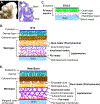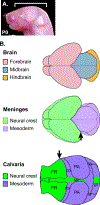Developmental biology of the meninges
- PMID: 30801905
- PMCID: PMC6520190
- DOI: 10.1002/dvg.23288
Developmental biology of the meninges
Abstract
The meninges are membranous layers surrounding the central nervous system. In the head, the meninges lie between the brain and the skull, and interact closely with both during development. The cranial meninges originate from a mesenchymal sheath on the surface of the developing brain, called primary meninx, and undergo differentiation into three layers with distinct histological characteristics: the dura mater, the arachnoid mater, and the pia mater. While genetic regulation of meningeal development is still poorly understood, mouse mutants and other models with meningeal defects have demonstrated the importance of the meninges to normal development of the calvaria and the brain. For the calvaria, the interactions with the meninges are necessary for the progression of calvarial osteogenesis during early development. In later stages, the meninges control the patterning of the skull and the fate of the sutures. For the brain, the meninges regulate diverse processes including cell survival, cell migration, generation of neurons from progenitors, and vascularization. Also, the meninges serve as a stem cell niche for the brain in the postnatal life. Given these important roles of the meninges, further investigation into the molecular mechanisms underlying meningeal development can provide novel insights into the coordinated development of the head.
Keywords: brain development; calvaria; craniofacial development; head mesenchyme; meninges.
© 2019 Wiley Periodicals, Inc.
Figures



References
-
- Angelov DN, & Vasilev VA (1989). Morphogenesis of rat cranial meninges. A light- and electron-microscopic study. Cell Tissue Res, 257(1), 207–216. - PubMed
Publication types
MeSH terms
Grants and funding
LinkOut - more resources
Full Text Sources

